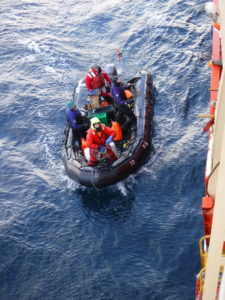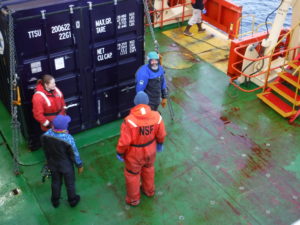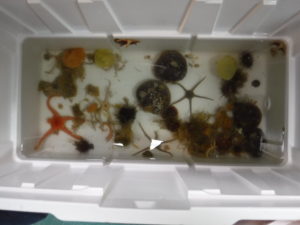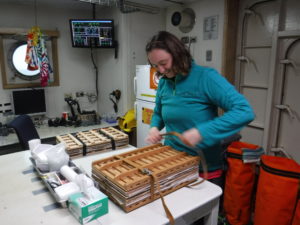Nearing the End
We are down to our last 2 days of science time on the cruise. That doesn’t really mean an end to the work though. We need to wash everything and pack it away for our next cruise in November. We also need to pack our samples and fill out tons of paper work in order to get them shipped home. And we need to disassemble the lab and return all of the borrowed equipment back in to the ship.
We will meet up the Nathaniel B Palmer (aka “the Natty B”) in a few days to transfer containers of fresh supplies for Palmer Station onto the Gould (aka “the Larry G”). The Natty B is too large to tie up at the Palmer dock, so they can’t deliver the supplies themselves. After that, we will continue heading north to pick up the leopard seal researchers at Cape Shirreff.
There is another group of researchers on the ship; Dr. Chuck Amsler and his colleagues are studying macroalgal (aka seaweeds) diversity and distribution, and the invertebrates that live with them. They are the divers that I mentioned in an earlier post. They go out in teams of two, with an observer and a zodiac driver (one of the marine techs), and collect samples either along a defined transect line, or in a defined region of the seafloor. They also take video while they dive – of the seafloor, not necessarily each other, although that does sometimes happen. What they collect is brought back to the ship, and the researchers spend several hours sorting the samples and archiving them for different analyses. Their dives last less than an hour because the water is so cold, even with their dry suits and the insulation that they wear inside.


I’d like to make special mention of the fact that Maggie Amsler completed her 500th Antarctic dive on this cruise! (Maggie has her back to us, in the dive suit with the blue/white pattern on the shoulders
The samples are processed for things like genetic analyses and fatty acid analyses, which allow identification of relationships between individuals and what resources they are using/making. They also create archival records of the seaweeds by pressing and drying them (see below). These are remarkably stable, and most macroalgologists (I don’t know if that’s the correct term) have their own individual collections (called herbaria). Kind of like stamp collecting.




The reason they are doing this project is because it’s been several decades since the region has been surveyed for seaweed diversity and distribution, and the extent of change in seasonal air/water temperature and sea ice cover suggested that this would likely have impacted the seaweeds. Macroalgae are important in the benthic invertebrate food web. While they do not directly serve as sources of nutrition, they can be hiding places for smaller invertebrates, or juveniles of larger species, and they provide surfaces where diatoms and bacteria (which serve as food) can grow. So, the loss of, or change in distribution of, seaweeds will have effects upwards through the food chain. Furthermore, because many macroalgae are chemically defended, there is much interest in whether some organisms have evolved to tolerate these chemicals in order to be able to actually eat seaweeds.